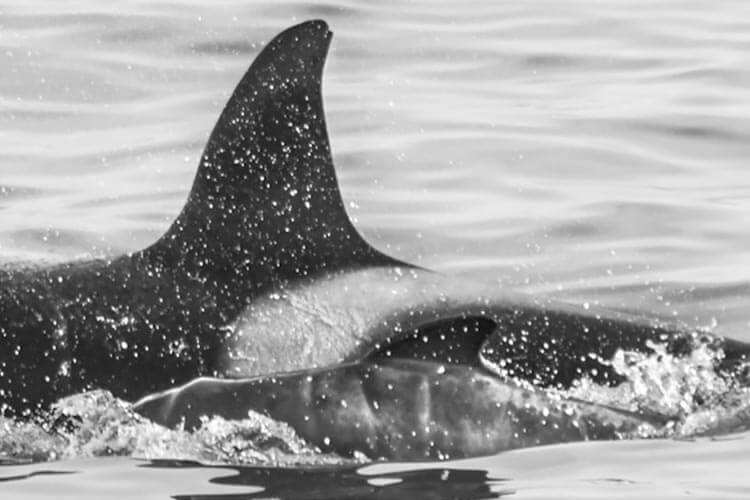
A study by researchers from the West Iceland Nature Research Centre (Náttúrustofa Vesturlands) has published the first documented case of a pilot whale calf being cared for by an adult female orca (killer whale).
The scientists were observing a pod of three orcas (Orcinus orca – also known as killer whales) and a group of pilot whales (Globicephala melas) during a trip off the coast of Snæfellsnes, Iceland, in 2021, when lead researcher Marie-Thérèse Mrusczok noticed that one of the female orcas was accompanied by a calf that appeared to be missing the distinctive white ‘eye patch’ for which orcas are known.
On closer investigation, the shape of the calf’s head and dorsal fin identified it as a long-finned pilot whale. The female orca – known as Sædís – was seen to be swimming with the calf in the protective ‘echelon position’ – a position behind the dorsal fin of the larger adult which effectively carries the calf along on the pressure wave created by the movement of the adult’s tail.
More great reads about killer whales:
‘You know what you’re seeing, but your mind is saying, “No, that can’t be,”‘ said Mrusczok, president Orca Guardians Iceland, who was working as a spotter for the whale watching tour that day. ‘When I came down from the top deck, the whole crew was like, “Wow, this is the tiniest orca calf we have ever seen.”‘
Interactions between killer whales and pilot whales around Iceland have been documented in the past, often with the pilot whales chasing the orcas to drive them away – but without actually catching them – in what is thought to be the result of competition for food.
Predatory attacks by orcas on pilot whales have also been documented, although these are rare; with only one such case having been recorded in Iceland’s waters.
The question as to why the female orca chose to take the pilot whale calf into her care remains unanswered. Sædís has never been seen with her own calf since she was first observed in 2012, and it is, therefore, unlikely she would have been able to nurse the pilot whale calf, which was described by the scientists as a newborn, and its body condition as ’emaciated’.
Nevertheless, Mrusczok said that Sædís ‘was showing protective … and caregiving behaviour towards the calf.’
The orca pod to which Sædís belongs was not seen again until July 2022, when she was observed among an association of 10 orcas were seen interacting with an ‘approximately 40-strong’ group of pilot whales. The pilot whale calf that Sædís had cared for was no longer present, and – given its poor condition – thought to have died.

The pilot whales – with a number of calves in tow – were seen chasing the pod of orcas as per the previously observed behaviour, however, in the July 2022 encounter, once the chase had ended, the orcas turned and began to slowly swim back towards the whales.
As the orcas approached the much larger group of pilot whales, the whales turned and drove them off again, only for the orcas to turn around a second time once the pursuit had ended – behaviour that had never before been observed.
The interaction was repeated again for the whale-watching boat left the area, implying the orcas were persisting in trying to close in on the pilot whales, leading to speculation that they may be attempting to replace the calf that Sædís had been seen with the year before.
Alloparental care – in which the adult of one species cares for the young of another – is well documented within the animal kingdom; humpback whales and several species of dolphin have been observed caring for the offspring of other species.
The new study is the first to document the behaviour between orcas and pilot whales, however, and suggests the known interspecies interactions may be far more complicated than previously observed.
The complete paper ‘First account of apparent alloparental care of a long-finned pilot whale calf (Globicephala melas) by a female killer whale (Orcinus orca)’ by Marie-Thérèse Mrusczok et al is published in the Canadian Journal of Zoology.
- Insta360 X5 action camera dive bundle review - 19 December 2025
- Order now! DIVE Winter 2026 print issue preview - 18 December 2025
- AIMS trials large-scale coral restoration during Great Barrier Reef spawning - 18 December 2025


